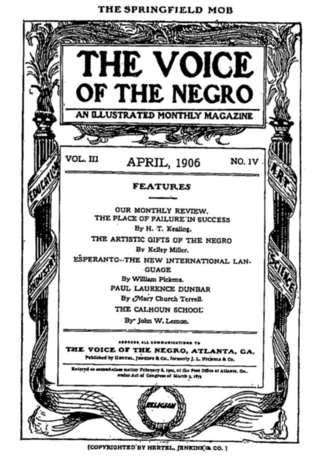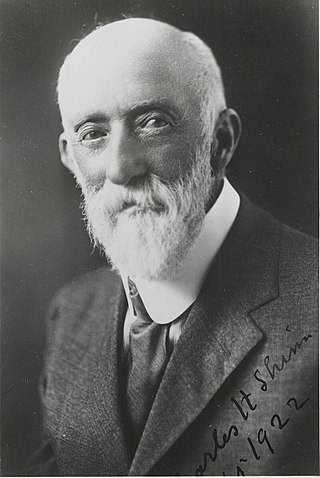
Thorstein Bunde Veblen was an American economist and sociologist who, during his lifetime, emerged as a well-known critic of capitalism.

The Bookman was a literary journal established in 1895 by Dodd, Mead and Company
Physical Review is a peer-reviewed scientific journal established in 1893 by Edward Nichols. It publishes original research as well as scientific and literature reviews on all aspects of physics. It is published by the American Physical Society (APS). The journal is in its third series, and is split in several sub-journals each covering a particular field of physics. It has a sister journal, Physical Review Letters, which publishes shorter articles of broader interest.

John Bates Clark was an American neoclassical economist. He was one of the pioneers of the marginalist revolution and opponent to the Institutionalist school of economics, and spent most of his career as professor at Columbia University.
Current History is the oldest extant United States-based publication devoted exclusively to contemporary world affairs. The magazine was founded in 1914 by George Washington Ochs Oakes, brother of The New York Times' publisher Adolph Ochs, in order to provide detailed coverage of World War I. Current History was published by the New York Times Company from its founding until 1936. Since 1942 it has been owned by members of the Redmond family; its current publisher is Daniel Mark Redmond.
The Yale Review is the oldest literary journal in the United States. It is published by Johns Hopkins University Press.
Stuart Chase was an American economist, social theorist, and writer. His writings covered topics as diverse as general semantics and physical economy. His thought was shaped by Henry George (1839-1897), by economic philosopher Thorstein Veblen (1857-1929), by Fabian socialism, and briefly by the Communist social and educational experiments in the Soviet Union to around 1930, though Chase was broadly a modern American liberal.

Edward Alsworth Ross was a progressive American sociologist, eugenicist, economist, and major figure of early criminology.

Milicent Washburn Shinn was a writer, editor, and child psychologist. She was the first woman to receive a doctorate from the University of California, Berkeley. She entered the State University in September 1874 and finished her undergraduate degree in 1880. She was one of three student speakers at the commencement. She edited the Overland Monthly from 1882 to 1894. She received her Ph.D. in 1898 at the age of 40.

Edmund Clark Sanford (1859–1924) was an early American psychologist. He earned his PhD under the supervision of Granville Stanley Hall at Johns Hopkins University, and then moved with Hall to Clark University in 1888, where he became the professor of psychology and the founding director of the psychology laboratory. He is best known for his 1887 Writings of Laura Bridgman and for his 1897 textbook, A Course in Experimental Psychology. This textbook was a manual on how to conduct experiential psychology. He was present at the creation of the American Psychological Association in 1892 and the creation of the Association of American Universities in 1900. He was the cousin of another early psychologist, Milicent Shinn.
Albert Hadley Cantril, Jr. was an American psychologist from the Princeton University, who expanded the scope of the field.

Thomas Nixon Carver was an American economics professor.

The Voice of the Negro was a literary periodical aimed at a national audience of African Americans which was published from 1904 to 1907. It was created in Atlanta, Georgia in June 1904 by Austin N. Jenkins, the white manager of the publishing company J. L. Nichols and Company. He gave full control of the magazine to the Black editors John W. E. Bowen, Sr. and Jesse Max Barber.

George Gunton was an influential figure in the labor movement of the United States around the turn of the 20th century and was an avid supporter of industrial combinations and trusts. He was a close colleague of Ira Steward, and upon Steward's death in 1883 he agreed to complete and prepare for publication a book that Steward had been writing. Gunton found only notes, not a nearly complete book. Deciding the notes were not sufficient for editing, Gunton discarded them, instead building on the ideas of his colleague to formulate his own book on the labor movement, Wealth and Progress, which was published in 1887, followed by Principles of Social Economics in 1891. He founded a school, the Institute of Social Economics, in 1891, with the aim of educating the masses in the path of responsible citizenship.

David MacLean Parry was an American industrialist and writer.

Engineering Magazine was an American illustrated monthly magazine devoted to industrial progress, first published in 1891. The periodical was published under this title until October 1916. Sequentially from Nov. 1916 to 1927 it was published as Industrial Management.
Horace Bookwalter Drury was an American economist, lecturer at Ohio State University, and management author, particularly known for his early work on scientific management.

Charles Howard Shinn (1852–1924) was a horticulturalist, author, inspector of California Experiment Stations, and forest ranger in California.

Kalākaua was the last king and penultimate monarch of the Kingdom of Hawaiʻi. The inherited position of the kingdom's monarch became a legislatively elected office with Lunalilo. Upon Lunalilo's death, Kalākaua won election over his political opponent Queen Emma. He reigned from February 12, 1874, until his death in San Francisco, California, on January 20, 1891.

Mary Raphael Schenck Woolman was an American educator known for her advocacy of vocational education and consumer education, particularly for women. She was one of the first woman faculty members at Teachers College in New York City. She was the founder of Manhattan Trade School for Girls, the first vocational school for women in the United States. She was the author of several books and lectured around the country.














